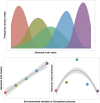Seeing the forest for the genes: using metagenomics to infer the aggregated traits of microbial communities
- PMID: 25429288
- PMCID: PMC4228856
- DOI: 10.3389/fmicb.2014.00614
Seeing the forest for the genes: using metagenomics to infer the aggregated traits of microbial communities
Abstract
Most environments harbor large numbers of microbial taxa with ecologies that remain poorly described and characterizing the functional capabilities of whole communities remains a key challenge in microbial ecology. Shotgun metagenomic analyses are increasingly recognized as a powerful tool to understand community-level attributes. However, much of this data is under-utilized due, in part, to a lack of conceptual strategies for linking the metagenomic data to the most relevant community-level characteristics. Microbial ecologists could benefit by borrowing the concept of community-aggregated traits (CATs) from plant ecologists to glean more insight from the ever-increasing amount of metagenomic data being generated. CATs can be used to quantify the mean and variance of functional traits found in a given community. A CAT-based strategy will often yield far more useful information for predicting the functional attributes of diverse microbial communities and changes in those attributes than the more commonly used analytical strategies. A more careful consideration of what CATs to measure and how they can be quantified from metagenomic data, will help build a more integrated understanding of complex microbial communities.
Keywords: community-aggregated traits; metagenomics; microbial diversity; microbial ecology; traits.
Figures

References
-
- Bailey V. L., Smith J. L., Bolton H. (2002). Fungal-to-bacterial ratios in soils investigated for enhanced C sequestration. Soil Biol. Biochem. 34 997–1007 10.1016/S0038-0717(02)00033-0 - DOI
-
- deBello F., Lavorel S., Lavergne S., Albert C. H., Boulangeat I., Mazel F., et al. (2013). Hierarchical effects of environmental filters on the functional structure of plant communities: a case study in the French Alps. Ecography 36 393–402 10.1111/j.1600-0587.2012.07438.x - DOI
LinkOut - more resources
Full Text Sources
Other Literature Sources
Miscellaneous

